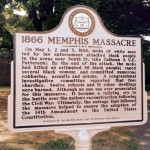On May 20-21, 2016, the University of Memphis will host “Memories of a Massacre: Memphis in 1866, a Symposium Exploring Slavery, Emancipation, and Reconstruction.” The culmination of a semester-long series of lectures, workshops, discussions, and book talks, this symposium will feature historians and scholars from across the country, including Robert K. Sutton, Chief Historian of the National Park Service. Together, their presentations and the ensuing discussions will pry open what has for 150-years been the carefully concealed history of Reconstruction, its legacies, and the significant role that Memphis played in both. As both a scholar and Communication Director of the project I am thrilled to be a part.
In my researching of the ways media helped shaped the narrative of the Massacre (one sadly we are still living in today), I ran across a story that I found quite interesting. On May 12, 1866, the Memphis Public Ledger reported a story about a German man from Cincinnati who was in Memphis during the Massacre. The report said that the man was “so terrified by the excitement that he became partly deranged.” Further the report stated that this man continue to give evidences of the terror of the riots (massacre) and always finishing with
Due to his “derangement” a friend watched and guarded him when traveling. However, one Saturday evening as the two were traveling by ship and after the German retired for the evening, his friend decided to get up and leave the cabin. When the friend came back to the room he found the door locked and after trying to get in, his friend found the “occurrence” funny. However, suddenly, the German man rushed from the room, passing by the guards on the ship and he jumped overboard and drowns.
When I read this, I could not help but to think about the horror of the Memphis Massacre. It really must have been intense. So intense that a man who just witnessed the carnage was so distraught that he committed suicide. But then my mind began to think about the black people who also witnessed and survived the massacre. What about the women who survived the rape and abuse? What about the men who were beaten and left for dead? What about the one woman who held the head of her tortured husband in her lap as he slowly died? And what about the children who witness the carnage? How did they survived? How did they make it? Did any of them “lose it” or become “deranged?”
These questions many times are not reflected upon because we are busy producing and promoting a narrative that highlights the strength and vitality of the Memphis black community or what I call the “how we bounced back” narrative. While we may discuss the Memphis Massacre as a tragic and troubling event, we are also quick to promote how black Memphians rebuilt their community. While hopeful and optimistic, we sometimes forget that the Memphis Massacre (May 1-3, 1866) was a police inspired and carried out event that systematically and without regard to black humanity destroyed not only schools, churches, and homes, but also killed 46 people and injured many more. And the truth is that while some “bounced back,” many others did not. What happened to them? Where are their stories? We hope this symposium is the beginning of that conversation and one that will produce fruitful results.
If you cannot attend the symposium, please follow us on Twitter @MemphisMassacre. We will also live tweet the event using #MemphisMassacre1866. You can also like us on Facebook.
Andre E. Johnson is an Assistant Professor of Communication at the University of Memphis and also the Communication Director for the Memories of a Massacre: Memphis in 1866 Project.
